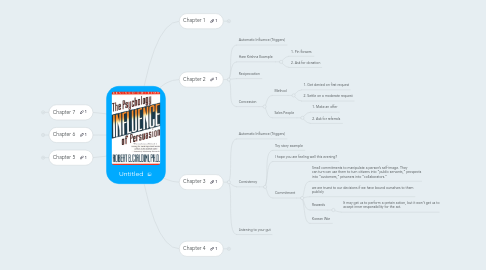
1. Chapter 1
1.1. Triggers for automatic compliance
1.1.1. As the stimuli saturating our lives continue to grow, we will depend increasingly on our shortcuts.
1.1.2. Harvard social psychologist Ellen Langer
1.1.2.1. Questions
1.1.2.1.1. because I’m in a rush.
1.1.2.1.2. May I use the Xerox machine?
1.1.2.1.3. Because I have to make some copies.
1.1.2.2. Why?
1.1.2.2.1. Asking someone to do us a favor we, will be more successful if we provide a reason.
1.2. The contrast principle
1.2.1. Showing a high price and then a low price
1.2.2. Buying a car and they selling accessories one by one
2. Chapter 7
2.1. Scarcity
2.1.1. We are more likely to take action when availability is limited
2.1.2. Examples
2.1.2.1. Wanting something that is banned
2.1.2.2. information that is banned
2.1.2.2.1. We believe in it more
2.1.2.3. Less food on the plate
2.1.2.4. Given and taken away
2.1.2.5. Social proof on demand
2.1.2.5.1. we want things more when we are in competition for it
2.1.3. How To Say No
2.1.3.1. Scarcity inhibits our ability to think
2.1.3.2. WHen is see something we want become scarce
2.1.3.2.1. physical agitation sets in
2.1.3.2.2. during competition
2.1.3.2.3. knowing is cognitive
2.1.3.3. Use the arousal as the cue
2.1.3.3.1. flag the emotion
2.1.3.3.2. evaluate for scarcity tactics
2.1.3.4. Ask, why do you really want the item
2.1.3.4.1. economic benefits
2.1.3.4.2. Psychological benefits
3. Chapter 2
3.1. Automatic Influence (Triggers)
3.2. Hare Krishna Example
3.2.1. 1. Pin flowers
3.2.2. 2. Ask for donation
3.3. Reciprocation
3.4. Concession
3.4.1. Method
3.4.1.1. 1. Get denied on first request
3.4.1.2. 2. Settle on a moderate request
3.4.2. Sales People
3.4.2.1. 1. Make an offer
3.4.2.2. 2. Ask for referrals
4. Chapter 6
4.1. Authority
4.1.1. We are more likely to act on instructions given by someone who we perceive to be authoritative
4.1.2. Factors
4.1.2.1. Titles
4.1.2.2. Height
4.1.2.3. Clothes
4.1.2.4. Trappings
4.1.2.4.1. Jewellery
4.1.2.4.2. Cars
4.2. How To Say No
4.2.1. When should they be followed?
4.2.2. When should they be disregarded
4.2.3. Credentials vs topic at hand
5. Chapter 3
5.1. Automatic Influence (Triggers)
5.2. Consistency
5.2.1. Toy story example
5.2.2. I hope you are feeling well this evening?
5.2.3. Commitment
5.2.3.1. Small commitments to manipulate a person’s self-image. They can turn can use them to turn citizens into “public servants,” prospects into “customers,” prisoners into “collaborators.”
5.2.3.2. we are truest to our decisions if we have bound ourselves to them publicly
5.2.3.3. Rewards
5.2.3.3.1. It may get us to perform a certain action, but it won’t get us to accept inner responsibility for the act.
5.2.3.4. Korean War
5.3. Listening to your gut
6. Chapter 5
6.1. Liking
6.1.1. We are more likly to buy from who we like
6.1.2. Tupperware party
6.1.2.1. Invited over to our friends house
6.1.2.2. feel the pressure to by because we like them
6.1.3. Factors
6.1.3.1. Physical Attractiveness
6.1.3.1.1. talent
6.1.3.1.2. kindness
6.1.3.1.3. honesty
6.1.3.1.4. intelligence
6.1.3.1.5. halo effect
6.1.3.2. Similarity
6.1.3.2.1. We like people who are similar to us
6.1.3.2.2. Dress
6.1.3.2.3. Backgrounds
6.1.3.2.4. Interests
6.1.3.2.5. age
6.1.3.2.6. Religion
6.1.3.2.7. Politics
6.1.3.3. Compliments
6.1.3.3.1. We like flattery
6.1.3.3.2. We tend to believe praise even if it is false
6.1.3.4. Contact and Cooperation
6.1.3.4.1. We will tend to like someone who's face we see regularly
6.1.3.4.2. "we vs "they"
6.1.3.4.3. to combine, start group projects for a common goal
6.1.3.4.4. Good Cop/Bad Cop
6.1.3.5. Conditioning and Association
6.1.3.5.1. Bad news = bad people
6.1.3.5.2. Good news = good people
6.1.3.5.3. Pavlov's salivation theory
6.1.3.5.4. People assume that we have the same traits of those we associate with
6.1.3.5.5. By connecting ourselves to winners, we appear as winners ourselves to ourselves
6.1.3.5.6. we is used more in "victory"
6.1.4. How to say "No"
6.1.4.1. Don't attempt to restrain the methods used for "liking"
6.1.4.2. Ask yourself
6.1.4.2.1. Have I come to like this person more during our interaction?
6.1.4.2.2. Recall the reasons why
6.1.4.2.3. Do not reverse by disliking the person, people are authentically likable
6.1.4.3. Mentally separate yourself from the item presented
6.1.4.3.1. separate your feelings
6.1.4.3.2. decide based on the deal at hand
7. Chapter 4
7.1. Social Proof
7.1.1. Examples
7.1.1.1. Canned Laughter
7.1.1.2. Salting "tip jars"
7.1.1.3. Salting "collection baskets"
7.1.2. Practical use
7.1.2.1. copy
7.1.2.1.1. fastest-growing
7.1.2.1.2. largest-selling
7.1.3. points
7.1.3.1. when a situation is unclear, we look towards social proof
7.1.3.2. works better in some conditions and not in others
7.1.3.2.1. crime
7.1.3.2.2. traumatic situations
7.1.3.3. works better when the others are similar to us
7.1.3.4. Defence
7.1.3.4.1. exercise clear judgement and evaluation

